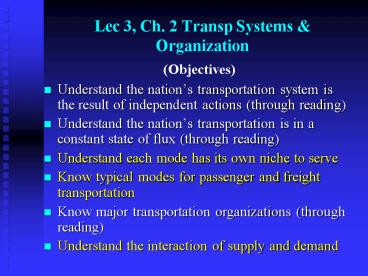Lec 3, Ch. 2 Transp Systems - PowerPoint PPT Presentation
1 / 12
Title:
Lec 3, Ch. 2 Transp Systems
Description:
Understand the nation's transportation is in a constant state of ... Intermodal Station near the Current Amtrak St. Downtown SLC. SLC Airport. Sandy Terminal ... – PowerPoint PPT presentation
Number of Views:103
Avg rating:3.0/5.0
Title: Lec 3, Ch. 2 Transp Systems
1
Lec 3, Ch. 2 Transp Systems Organization
(Objectives)
- Understand the nations transportation system is
the result of independent actions (through
reading) - Understand the nations transportation is in a
constant state of flux (through reading) - Understand each mode has its own niche to serve
- Know typical modes for passenger and freight
transportation - Know major transportation organizations (through
reading) - Understand the interaction of supply and demand
2
What we discuss in this lecture
- Forces affecting the nations transportation
- Typical modes for passenger and freight
transportation and modal networks - Niches of transportation modes and intermodalism
- Interaction of supply and demand
- Term project guidelines
3
Forces that change the transportation system
At any point in time, the nations transportation
is in a state of equilibrium as expressed by the
traffic carried for each mode and the level of
service provided (like time, cost, frequency, and
comfort).
Speed, capacity, range, reliability
Regulation, subsidy, promotion
4
Typical Modes Niches for Passenger Transport
Walking Biking
? Good for any areas and short distance trips.
Preferably flat terrain, good bike facilities
needed for safety
? Good for low density residential areas. Not so
good for high density residential and commercial
areas
? Good for high density areas and for delivering
passengers to various parts of the urban area.
Work as feeders to railway stations
? Good for high volume low to medium travel
distance, high volume areas or connecting high
volume areas. In the U.S. not much used for long
distances.
? Good for long distance travels that cannot be
served rails and buses (Travel time is crucial)
5
How do we select a mode? Advantages and
complementarity of modes
Each mode has inherent advantages of cost,
travel time, convenience, and flexibility that
make it right for the job under a certain set
of circumstances.
Example 2.1 400 mile trip
Select the best mode among the followings
Cost saving in travel time 25/hr
6
Intermodalism example Salt Lake City Intermodal
Station
Intermodal Station near the Current Amtrak St.
U
Downtown SLC
Sandy Terminal
SLC Airport
Provo/Orem
Payson
Commuter Train
7
Interaction of Supply and Demand
The extent and quality of the system in place
which constitutes the supply of transportation
facilities and services
The state of the economy which produces the
demand for transportation
Supply and demand reaches a state of equilibrium
when the users need is met by the existing
supply.
8
Figure 2.2 A new bridge to the mainland
Demand Cost relationship
Mainland
Equilibrium state
Cost/mi
Inaccessible at present
Proposed toll bridge
0.2 (Toll)
Supply Cost relationship
Island
Demand side Less cost, More demand
Traffic volume (1000 units/day)
2
Supply side Cost Fixed Cost Toll Travel
Time Since the facility capacity is fixed, more
demand means higher travel cost due to delay.
Shows how the available supply is affected by the
volume of traffic that uses the system (demand).
9
Problem 2-3 (a)
Supply side C 50 0.5V Fixed cost Travel
time cost
Equilibrium
C Cost/veh
Demand side V 2500 10C i.e. C 250 V/10
50 fixed cost
2500
V Volume
(a) Asks for Volume at current equilibrium
10
Problem 2-3 (b)
New Equilibrium
Old Equilibrium
New Supply side C 50 25 0.5V FC Toll
Travel Time
C Cost/veh
Demand side V 2500 10C i.e. C 250 V/10
50 fixed cost
2500
V Volume
(b) Asks for Volume at the new equilibrium
11
Problem 2-3 (c) Extra toll booth, less travel
time cost
Supply side C 50 0.2V Fixed cost Travel
time cost
Old Equilibrium
C Cost/veh
New Equilibrium
Demand side V 2500 10C i.e. C 250 V/10
50 fixed cost
2500
V Volume
(c) Asks for Volume at the new equilibrium after
the service is increased
12
Problem 2-3 (d) Max revenue with a toll(Toll
agencys desire)
dR/dT 0
Revenue Toll Volume R T
V Find V first from V 2500 - 10(C) V 2500 -
10(50 0.5V T) So, V 2500 500 5V
10T Hence V (2000 10T)/6 Plug this V in R
TV T(2000-10T)/6
(2000T 10T2)/6 You know what to do to get
optimal T ? dR/dT 0
R
To
T
2000 20T 0 Hence To 100 cents































